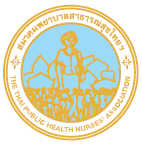Factors Associated with Intention to Quit Smoking By Males with Chronic Diseases
Keywords:
Intention to Quit Smoking, Males with Chronic DiseasesAbstract
Smoking is advised against for people with chroic diseases. However, those who still smoke experience a lot of negative effects.. The purposes of this collelation study were to describe intention to stop smoking and to examine factors associated with intention to quit smoking among males with chronic diseases. Participants were 100 males with the type 2 Diabetes Mellitus or Hypertension in Wangnamkhiao district, Nakhonratchasima province. Data were collected with questionaires. Statistics were reported as percentage, mean, and standard deviation. Pearson product moment correlation was used for data analysis.
Intention to quit smoking was highest at 6 months and decreased at 3 months and 1 month. The overall intention to quit smoking was moderate. The significant factors associated with intention to quit were self-efficacy related to smoking cessation (r = .480, p < .001), social support (r = .346, p < .001), attitude towards smoking cessation (r = .290, p < .01), income (r = .218, p < .05) and cigarettes smoked per day (r = -.180, p < .05).
Results provide basic knowledge for the development of effective smoking cessation programs for those with chronic diseases. Findings indicate a need to focus on sefl-efficacy to enhance beliefs in one’s ability to stop smoking, changing attitudes towards smoking cessation, and social support from family and health personnel.
References
2. Bureau of Non-Communicable Disease. The number of patients. Ischemic heart disease / diabetes / high blood pressure / stroke / bronchitis / emphysema and chronic obstructive lung disease / asthma since 2007-2015. [cited 2015 May 15]. Available from: http://www.thaincd.com/document/file/i nfo/non-communicable-disease/ (in Thai)
3. Health info in Thailand. Health indicator 2012. [cited 2014 March 2]. Available from: https://www.hiso.or.th/health/images/ind icators/indicators1.pdf (in Thai)
4. Pitayarangsarit, S., Eamanan, P., Punkrajang, P., & Sommit, K. Summary of tobacco situation in Thailand 2012. Bangkok: Chrareandeemonkong printing; 2012. (in Thai)
5. Bussaratid. S. & Siripaiboonkij. A. Study of smoking cessation rate at smoking cessation clinic, Siriraj Hospital, Thailand. Journal of Psychiatric Association of Thailand. 2012; 57(3): 305-312. (in Thai)
6. Fishbein, M. An integrative model for behavioral prediction and its application to health promotion. In R. J. Diclemente, R. A. Crosby, & M. C. Kegler (Eds), Emerging theories in health promotion practice and research (2nd ed.; pp. 215- 234). San Francisco: Jossey-Bass; 2009.
7. Paha, K., & Prechawong, S. Attitudes, subjective norm, perceive behavioral control, and intention to quit smoking in police officers. Journal of the police nurse. 2014; 6(1): 157-169. (in Thai)
8. Kaleta D., Korytkowski, P., Dabrowska, T. M., Usidame, B., Romaniszyn, L. B., & Fronczak A. Preditors of long-term smoking cessation: results from the global adult tobacco survey in Poland(2009-2010). BMC Public Health. 2012; 12(1): 1-13.
9. Ayo-Yusuf, O. A., & Szymanski, B. Factors associated with smoking cessation in South Africa. The South African Medical Journal. 2010; 100(3): 175-179.
10. Patel, K., Schundt, D., Larson, C., Wang, H., Brown, A., & Hargreaves, M. Chronic illness and smoking cessation. Nicotine & Tobacco Research. 2009; 11(8): 933-939.
11. Parama. S. Health beliefs and selfcare behaviors in diabetes mellitus patients at Lee hospital, Lamphun province. [Thesis in Master thesis Education Psychology and Guidance], Faculty of Education, Chiangmai University. 2002.
12. Matrakul, M., Kalampakorn, S., & Powwattana, A. (2555). Factors predicting intention to quit of hand-rolled Cigarettes smokers in Chiangrai Province. Thai journal of nursing. 2012; 61(1): 12- 20. (in Thai)
13. Tsai, A. C., Lin, Y. A., & Tsai, H. J. Predictors of smoking cessation in 50-60- year-old male Taiwanese smoker: A 7- year national cohort study. Archives of gerontology and geriatrics. 2012; 55(2): 295-300.
14. Panda, R., Venkatesan, S., Persai, D., Trivedi, M., & Mathur, M. R. Factors determining intention to quit tobacco: exploring patient responses visiting public health facilities inIndia. Tobacco Induced Diseases. 2014; 12(1): 1-10.
15. Yang, M., Essien, E. J., Sansgiry, S. S., Wu, I. H., Peters, R. J., & Abughosh, S. Predictors of intention to quit cigarette smoking among Chinese adult. Journal Behav Health. 2012; 1(2): 93-101.
16. Girma, E., Assefa, T., & Deribew, A. Cigarette smokers’ intention to quit smoking in Dire Dawa town Ethiopia: an assessment using the Transtheoretical Model. BMC Public Health. 2010; 10(1): 1- 7.
17. Garcia, G. M., Romero, R. A., & Maxwell, A. E. Correlates of Smoking Cessation Among Filipino Immigrant Men. Journal of Immigrant and Minority Health. 2010; 12(2): 259-262.
18. Reid, J. L., Hammond, D., Boudreau, C., Fong, G. T., & Siahpush, M. Socioeconomic disparities in quit intentions, quit attempts, and smoking abstinence among smokers in four western counties: Findings from the International Tobacco Control Four Country Survey. Nicotine & Tobacco Research. 2010; 12(1): s20-s33.
19. Pantaewan, P., Onsri, P., & ounjaichon, S. Beliefs smoking behavior and smoking cessation among Thai military conscripts. Journal of the royal thai army nurses. 2010; 11: 59-65. (in thai)
20. Flay, B. R., & Petraitis, J. The theory of triadic influence: A new theory of health behavior with implications for preventive interventions. Advance in Medical Sociology. 1994; 4: 19-44.
21. Parel, C.P., Caldito, G.C., Ferrer, P. L., De Guzman, G. G., Sinsioco, C. S., & Tan, R. H. Sampling design and procedures. 1973; n.p.
22. Homsin, P., Srisuphan, W., Pohl, J. M., Tiansawad, S., & Patumanond, J. Predictors of Early Stages of Smoking Uptake among Thai Male Adolescents. Thai Jornal Nursing Research. 2009; 13(1): 28-42.
23. Velicer, W. F., Diclemente, C. C., Rossi J. S., & Prochaska J. O. Relapse situations and self-efficacy: an integrative model. Addictive Behaviors. 1990; 15(3): 271-283.
24. Jirojanakul, P. Concepts, Theories on health promotion and their application. Nonthaburi: Praboromarajchanok Institute; 2013. (in Thai)
25. Homsin, P. Concepts and theories for practice: smoking and alcohol drinking prevention among adolescents. Chonburi: Chonburi printing; 2015. (in Thai)
26. Bandura, A. Social foundations of thought and action: A social cognitive theory.New Jersey: Prentric-Hall; 1986.
27. Karom, N., & Prechawong, S. Predictors of short-term smoking cessation among patients with chronic disease. Nursing journal. 2015, 42(1): 1-11.
Downloads
Published
How to Cite
Issue
Section
License
บทความที่ตีพิมพ์และแผนภูมิรูปภาพถือเป็นลิขสิทธิ์ของวารสารพยาบาลสาธารณสุข (Thai Public Health Nurses Association)







